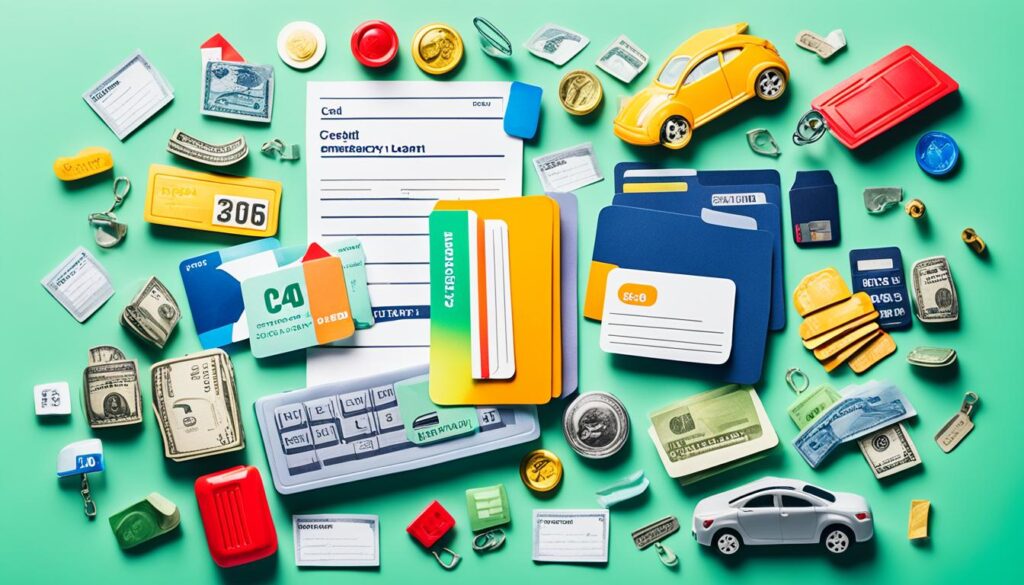Emergency loans are loans that help cover sudden financial needs. They offer quick cash access. Knowing what emergency loans are can help you find help when you need it most.
“A budget is telling your money where to go instead of wondering where it went.” – Dave Ramsey. Sometimes, unexpected costs pop up, and having money set aside is key. Emergency loans can help by offering fast cash and quick approval for things like sudden medical bills, car fixes, or urgent travel costs. When money worries hit, knowing the best loan options is vital. This guide will help you understand emergency loans, the different types, and how to find the right one for your needs.
- Emergency loans offer quick cash for unexpected expenses.
- Understanding various types of loans can help you make informed decisions.
- Interest rates, loan terms, and approval speed are critical factors.
- Comparing lenders increases your chances of securing the best terms.
- A good credit score can improve your chances of fast approval.
Definition of Emergency Loans
Emergency loans are personal loans for urgent costs without needing collateral. They are unsecured loans, so lenders check your credit, income, and debts to decide if you can get one. These loans can be small, from $1,000 to $100,000. You can get the money fast, often in 1 to 7 business days. Some lenders can give you money the same day in emergencies.
When to Consider an Emergency Loan
You might think about emergency loans for sudden costs like big medical bills, urgent home fixes, or key car repairs. They’re great when your money is tight because of a sudden job loss or unexpected bills. If you’re struggling to pay for everyday things, knowing about emergency loans can help you find quick financial support.
Types of Emergency Loans Available
When you face unexpected costs, knowing about emergency loans can help you decide. Here are the main types to think about.
Unsecured Personal Loans
Unsecured personal loans are good if you don’t want to use collateral. Lenders check your credit to see if you can get one. These loans usually have higher interest rates than secured loans. But, they let you get money fast without needing collateral.
Secured Personal Loans
Secured personal loans need collateral, like a car or savings. They’re less risky for lenders, so they often have lower interest rates. If your credit score is low, these loans might be easier to get, making them a good choice.
Payday Loans and Their Risks
Payday loans are meant for short-term needs and come with high costs. They have very high-interest rates that can trap you in debt. It’s important to know the risks of payday loans, as their APR can reach up to 400%. This can lead to financial trouble if not handled well.
Credit Card Cash Advances
Credit card cash advances let you take cash from your credit limit. They offer quick money access but have higher interest rates than regular purchases. You’ll also face fees of 3% to 5%, making them less ideal than other emergency loan options.

| Type of Loan | Collateral Required | Interest Rates | Typical Loan Terms |
|---|---|---|---|
| Unsecured Personal Loans | No | Higher | 2-7 years |
| Secured Personal Loans | Yes | Lower | 2-7 years |
| Payday Loans | No | Very High (up to 400% APR) | Short-term |
| Credit Card Cash Advances | No | Higher than Purchases | Varies |
Each emergency loan type has its pros and cons, fitting different financial situations. Knowing about these options helps you make smart choices when you need them most.
How to Choose the Right Emergency Loan
Choosing the right emergency loan means looking at several important factors. You need to know what you can afford to borrow and understand the loan terms. This will help you make a smart choice.
Assessing Loan Amounts and Terms
Emergency loans can be from $1,000 to $100,000, based on the lender and your credit score. Make sure the loan amount matches your needs and fits your budget. For example, if you need to fix your home for less than $5,000, you might not need a big loan with high monthly payments.
Choose terms that you can easily afford each month. This way, you won’t struggle financially.
Comparing Interest Rates and APRs
It’s important to compare interest rates, especially the annual percentage rate (APR). Rates can be as low as 6% for great credit, but can go up to 36% for poor credit. Knowing these rates and how they affect your total cost helps you pick the best loan.
Some loans offer quick money but have higher rates. Think about how fast you need the money when comparing rates.
Understanding Fees and Additional Costs
Look closely at loan fees when choosing a loan. Origination fees can be 1% to 10% of the loan. Credit card cash advances might have fees of 3% to 5%, making your total cost go up. Knowing these fees helps you avoid surprises and manage your payments better.
| Loan Type | Loan Amounts | Interest Rates/APR | Typical Fees |
|---|---|---|---|
| Personal Loans | $1,000 – $100,000 | 6% – 36% | 1% – 10% origination fee |
| Payday Loans | Up to $250 | Up to 400% | High fees, sometimes $15 per $100 borrowed |
| Title Loans | 25% – 50% of car value | 300% average | Varies; often includes high fees |
| Credit Card Cash Advances | Varies | Variable, often higher than personal loan | 3% – 5% transaction fee |
How to Get Approved for an Emergency Loan
Getting an emergency loan is crucial when you need money fast. Knowing how to apply can boost your chances of approval. You need to check your credit score, gather documents, and pre-qualify with lenders. Each step is key to a smooth application process.
Checking Your Credit Score
First, check your credit score. This score is vital for loan eligibility and affects the loan terms. If your score is under 669, you’re seen as having fair or poor credit. This might lead to higher interest rates or loan denials. Fixing errors in your report can raise your score and improve your loan terms.
Gathering Necessary Documentation
Next, collect the needed documents. Lenders want different things, but here are some common ones:
- Valid government-issued ID
- Social Security card
- Proof of residence
- Proof of income (like W-2s or pay stubs)
Having these documents ready makes the process faster. It also shows lenders you’re organized and responsible. This can help you get an emergency loan approved.
Pre-qualifying with Lenders
Pre-qualifying with lenders is a wise step. It lets you see loan offers without hurting your credit score. By doing this, you can compare offers from different lenders. This way, you can pick the best rate for your finances.
| Step | Description |
|---|---|
| Checking Your Credit Score | Assess your score to understand eligibility and correct any discrepancies. |
| Gathering Documentation | Prepare necessary documents like ID, Social Security card, and proof of income. |
| Pre-qualifying with Lenders | Explore offers without affecting your credit score, comparing terms from various lenders. |
Where to Obtain Emergency Loans
When you need quick cash, knowing where to get emergency loans is key. You have several options that fit different situations. It’s important to look at each one to choose the best for your finances.
Online Lenders
Online lenders are popular for their easy applications and good rates. Sites like Upstart and LendingClub offer loans from $1,000 to more, needing just a few documents. But, pick reputable lenders to avoid high fees or rates.
Traditional Banks
Traditional banks have tough rules but offer low fees and rates. Banks like Marcus and Lightstream give loans with lower APRs than credit cards or payday loans. They look for credit scores over 600, so check yours before applying.
Credit Unions
Credit unions offer some of the cheapest emergency loans. They have loans up to 28% interest, much lower than payday lenders’ 400% APR. Credit unions might have special emergency loans up to $5,000, great for quick financial help.

